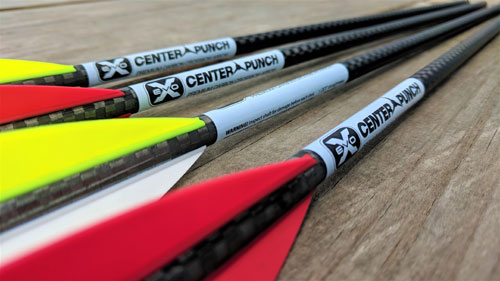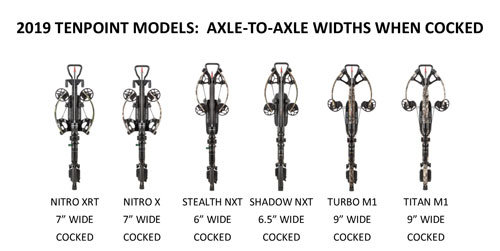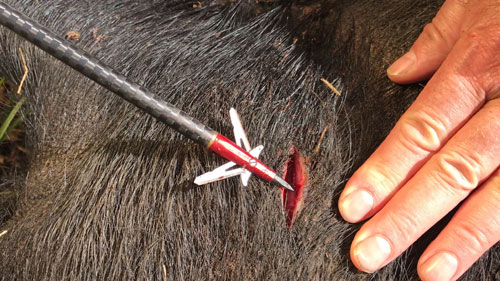Here is a list of five commonly used terms in the crossbow world that will help every new archer learn about and understand crossbows.
1. Arrow vs. Bolt
Do you shoot crossbow xe2x80x9carrowsxe2x80x9d or crossbow xe2x80x9cboltsxe2x80x9d? These days, people use these two names for a crossbowxe2x80x99s projectile interchangeably xe2x80x93 but which one is correct? There does not seem to be a clear answer to this question, since even crossbow and arrow manufacturers refer to them as crossbow arrows in some instances, and crossbow bolts in others. As crossbows have become a greater part of mainstream archery, the tendency has been to define the projectile based on its length. In other words, if the projectile is 16 inches or greater, it is referred to as an arrow. If it is less than 16 inches, it is called a bolt. Since the recommended projectile length of most modern hunting crossbows is 16 inches or longer, most modern crossbows shoot arrows and not bolts.

2. Power Stroke
This term is the crossbowxe2x80x99s equivalent to a vertical bowxe2x80x99s draw length. The power stroke is the distance that the crossbowxe2x80x99s string travels from its cocked position on the string latch, to its rested position after the shot. In short, power stroke describes the distance that the string accelerates the arrow down the flight rail. Hence, a crossbow with a longer power stroke means longer acceleration of the arrow and translates into faster arrow speeds. Conversely, a crossbow that has a shorter power stroke will yield slower arrow speeds. For example, the primary advantage of a reverse-draw-style crossbow over a forward draw is that the power stroke is elongated xe2x80x93 sometimes by a matter of inches xe2x80x93 which translates into faster speeds without adding extra draw weight to the crossbow string. There are other aspects of a crossbowxe2x80x99s parts and design that contribute to arrow speed, however, the length of a crossbowxe2x80x99s power stroke is the most significant contributing factor.

3. Up to Speed
If you go to any crossbow manufacturerxe2x80x99s website and look at the specifications of a crossbow, you will see verbiage stating something like, xe2x80x9cShoots up to 410 fps.xe2x80x9d This doesnxe2x80x99t mean that you can choose any arrow of any weight and that the crossbow will always shoot that arrow at 410 fps. This actually means that if you shoot the lightest recommended arrow possible out of the crossbow, the light arrow will shoot at 410 fps. Chances are good that you will not be shooting this light of an arrow out of your crossbow in a hunting situation, because a lighter arrow does not tend to group as tightly, nor does it carry the same amount of penetration power that a heavier arrow carries. If you are in the market to buy a hunting crossbow, you should inquire with your dealer or the manufacturer to determine how fast the crossbow shoots a heavier arrow appropriate for hunting, to get a better sense of the crossbowxe2x80x99s potential speed.
4. Axle-to-Axle Length
The axle-to-axle length measurement of a crossbow refers to the distance from the left cam axle to the right cam axle on the crossbowxe2x80x99s bow assembly. Typically, two axle-to-axle length measurements are given. One is determined when the bow assembly is not in the cocked position and the other by measuring when the crossbow is cocked. These measurements give you a sense of how wide or narrow the bow assembly is when cocked or not cocked. However, this measurement only captures the distance between the axles xe2x80x93 which could be located toward the center of the cams xe2x80x93 and it does not actually tell you how wide the crossbowxe2x80x99s bow assembly is overall. For example, if a crossbow has cams that are 5 inches in diameter and the axles are mounted in the center of the cams, then approximately 2.5 inches worth of cam distance on each side of the crossbow must be added to the axle-to-axle measurement to yield the crossbowxe2x80x99s overall width when cocked or not cocked.

5. Kinetic Energy
The kinetic energy of an arrow is how much energy the arrow carries while in flight. In other words, kinetic energy is a measurement of how much force is exerted by the arrow onto its target. Having a high amount of kinetic energy means that the arrow will hit the target harder and will penetrate farther than an arrow that carries a lower amount. The amount of kinetic energy is determined by multiplying the arrow speed in feet-per-second times itself, then multiplying that total by the arrow weight in grains, and finally dividing that number by 450,800. The result is the kinetic energy measurement of the arrow in foot-pounds of force. Since the force of the string accelerating the arrow down the flight rail is generally constant, a lighter arrow will accelerate faster down the flight rail and have a faster speed at the muzzle than a heavier arrow will. So, a lighter arrow moves at a faster speed than a heavier arrow does. But which is better for hunting? A heavier arrow that hits harder but flies more slowly, or a lighter arrow that flies fast but doesnxe2x80x99t hit with as much force? Most crossbow hunters choose the heavier arrow and are willing to sacrifice some arrow speed because of the increased amount of penetration power that the heavier arrow will inflict upon the animal.

xe2x80x94 PAID PARTNER CONTENT. This content is brought to you by a D&DH advertising sponsor.

